In the late fifteenth century Valtellina was a territory subject to the Republic of the Three Leagues, a federation formed by the Grey League, the League of the House of God, and the League of Ten Jurisdictions. In 1487 with an army from Chur made up of about 7,000 infantrymen and horses the League came to seize Tirano, Teglio and Sondrio until then under the Duke of Milan, Ludovico il Moro. The duke, after at first succeeding in retaking the valley, had to cede Valtellina as well to the king of France, Louis XII, in the year 1500, following the siege of Novara. In 1512, after about 12 years of despotic French rule, Valtellina passed back into the hands of the Grisons, who were at first welcomed with relief by the local populations.
Political-institutional developments were intertwined with the spread of reformatory instances and, especially following Lutheran preaching, with increasingly bitter tensions between the Church of Rome and the Reformed. As is well known, such exacerbations resulted a century later in the famous and sad episode of the Holy Slaughterhouse of 1620. From the beginning of the sixteenth century the “religious question,” though with different modulation and incidence according to places and periods, became central to developments in the entire Valtellina [Fay&Materietti 2016]. In this cultural humus and religious criticism should be framed, in the opinion of the writer, the choice of some of the decorations of the Besta Palace in Teglio commissioned by Azzo II and his wife Agnese Quadrio, and later , by Anna Travers, the Protestant wife of Charles I Besta.
The Besta Palace in Teglio (Fig. 1) represents a masterpiece of 15th-century Lombard Renaissance art. Positioned in the middle of Valtellina, on a plateau at an elevation of about 900 meters above sea level, it dominates the valley overlooking the Orobian Alps. Inside are decorations with cycles of frescoes on biblical, mythological and historical subjects dating from the 16th century.
Built at the behest of Azzo I Besta beginning in the second half of the 15th century, it was constructed by incorporating medieval buildings from an ancient house-fort. It was later to be his son Azzo II and his wife Agnese Quadrio who commissioned the pictorial decorations inside, transforming the palace into a true Renaissance court that would see numerous artists, men of wit and men of letters [Beniculturali 2024]. Andrea Guicciardi, stepfather of Azzo II, a man of culture and rector of the University of Pavia in 1498, also apparently participated in the completion of the decorative apparatus. The palace remained the property of the Besta and their heirs until 1726 when it became the property of the consul of justice Pietro Morelli, who made some internal changes such as the construction of the two stue towards the valley. The property was later dismembered among several peasant families who settled in the building and adapted it as a dwelling, stable and barn. From neglect and abandonment it was saved in 1911 by Luigi Perrone and Luca Feltrami, who had it purchased by the Italian state, which financed the restoration work that began in 1912 and was completed in 1927 [Galletti&Mulazzani 1983].
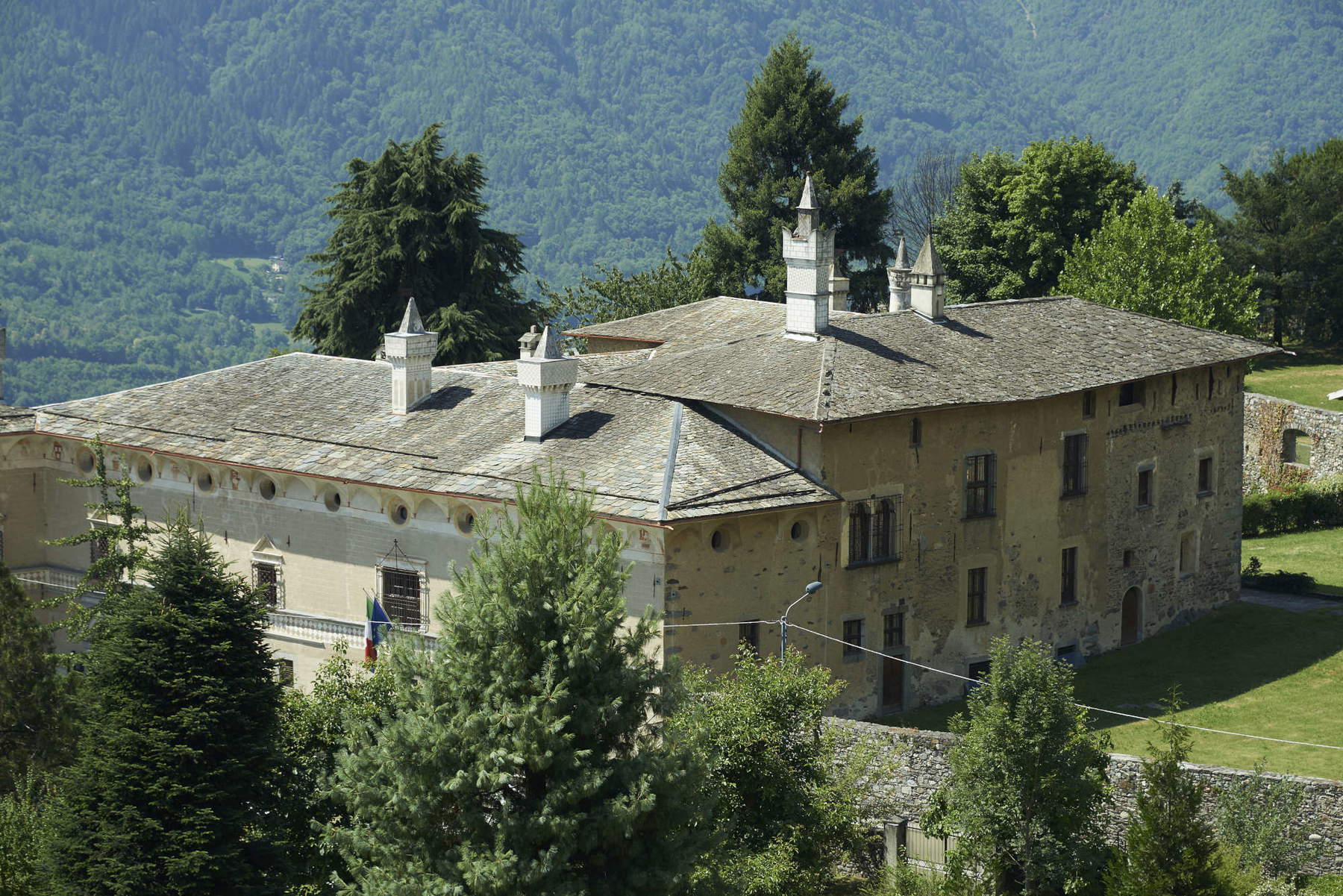
Inside the Palace, on the south wall of the hall of honor, with frescoes inspired byOrlando Furioso, in the part of the so-called “allegory cycle,” there is a fresco with powerful symbolic meaning. Because of its placement in the hall’s fresco cycle, it is accepted that it follows or is part of the allegories of greed. Several authors have ventured to interpret its message, but there is a general consensus that the panel remains difficult to penetrate. Indeed, Prati [Prati 2009] concludes, “Unfortunately, studies at the moment do not lead to a definitive conclusion, leaving the problem still open.”
In a bucolic setting a turtle-shaped chariot with wheels is surmounted by a chubby, stocky man bearing an armillary sphere in his left hand. The turtle-chariot is preceded by two ill-dressed, barefoot, partly disheveled commoners who, with great effort, drag the same bound to a yoke. A putto with strange features prods the two commoners, inducing them to continue the effort (Fig. 2).
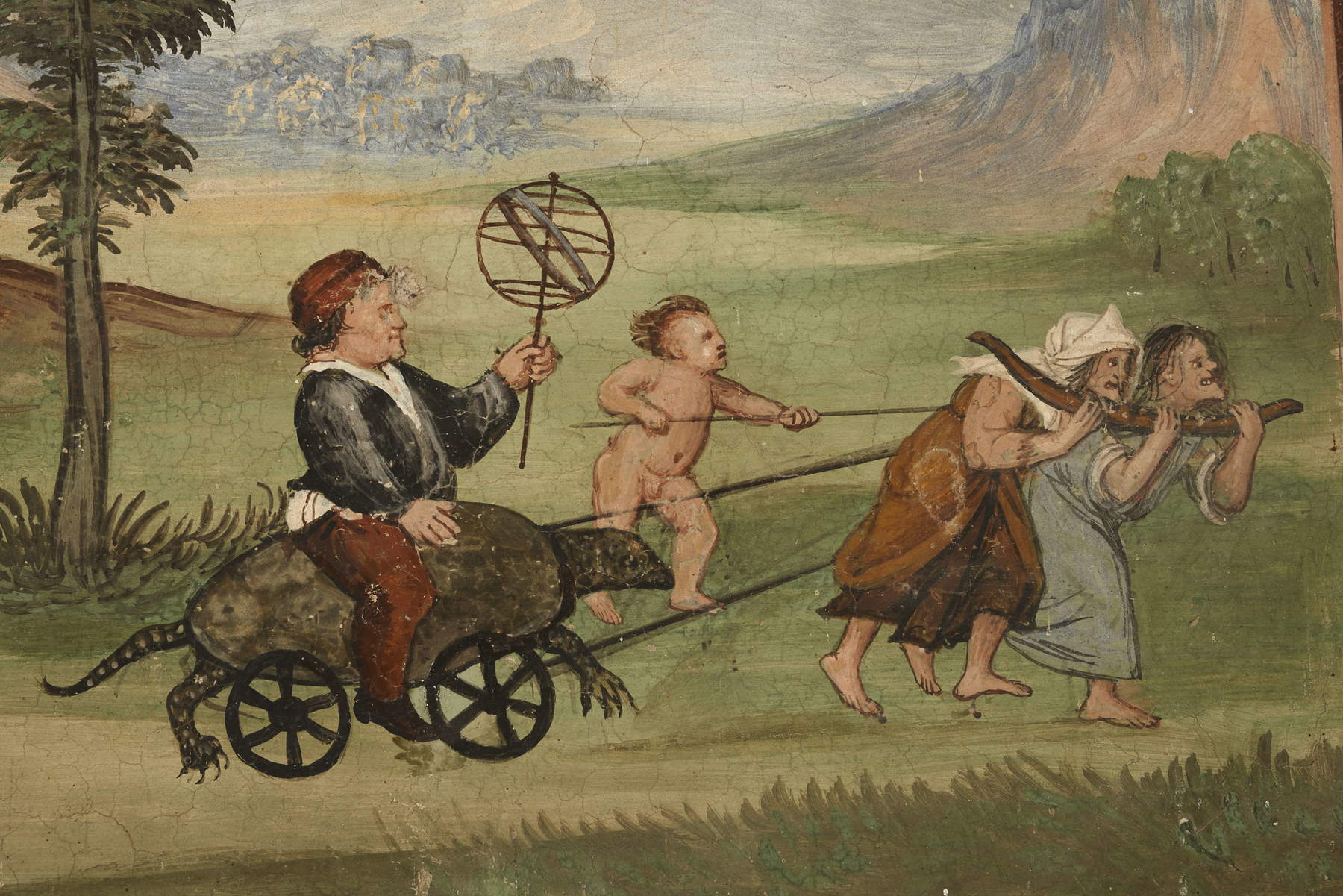
According to Cotogni, endorsed by Mazzoni Rajna [Mazzoni Rajna 1983], the scene should be read in an esoteric key since it would be to the knowledge of this discipline “that we owe this conception.” The turtle would be a symbol of the earth, the chubby man a White Magician who dominates reality with knowledge. The two women a message about dualism in man’s choices: choices made either with the intellect (veiled woman) or dragged by the passions (disheveled woman). The putto would represent eros “in its heroic hypostasis.”
For Birolli [Birolli 1976], otherwise, the scene would represent a “parody of a Triumph” because of the awkward and grotesque figures in the scene. Maria Luisa Gatti Perer [Gatti Perer 1984] would have seen idleness depicted as the captain of vices and already described by Ariosto as “corpulent and fat.” Then there is the opinion of Germano Mulazzani [Galletti&Mulazzani 1983] who, after calling the explanation endorsed by Mazzoni Rajna “challenging,” concludes that he is “[...] unable to take a position on this theme [for him] completely unknown.”
However suggestive and authoritative the past readings may be, they lack, in the writer’s opinion, an overall view that combines all the elements of the scene, contextualizing the explanation in the uniqueness of the historical period in which the frescoes in the palace were created. The thesis presented below is that the fresco is an allegory of the Church of Rome and its vices in an era, the 16th century, at the height of the moral decadence of the papacy.
The chariot-turtle symbolizes the Church of Rome itself (Fig. 3). With the choice of the turtle, the artist wanted to refer to an animal that is secular, slow, and gives the impression of immutability over time. In the same way, the Church of Rome was and is a secular institution, tending to preserve its nature over time, rigidly anchored in its dogmas, and which has walked and dominated the scene over the centuries at a cadenced and regular pace. The Encyclopedia of Symbols [The Universal 2003, entry “Turtle”] clearly states that “the turtle is the image of an animal that represents a hidden force and is able to protect itself from any external attack.” What better symbol for an institution that has survived for nearly two millennia? He then continues, “...because of its invulnerability it was the symbol of immutable order.” And again, “In Patristics, the animal ’living in the slime’ became the symbol of attachment to the earth” [The Universal 2003, entry “Turtle”]. And it is perhaps this image of all-earthly connection and materiality that may underlie part of the criticism that the sixteenth-century Reformist milieu made of the Roman institution.
In terms of artistic precedents, it is noted that in the basilica of Aquileia there is a floor mosaic dating back to the fourth century, representing an extraordinary example of early Christian mosaic art (the most extensive in the entire Western Christian world). In that era, similar to the Reformation period, symbolic language was a necessity for a community coming out of a period of atrocious persecution and which had had to communicate by symbols, seemingly harmless in the eyes of pagans, the contents of its faith. In that mosaic, and more specifically in the Theodorian North Hall and the South Hall, there is a depiction of a rooster wrestling with a tortoise.
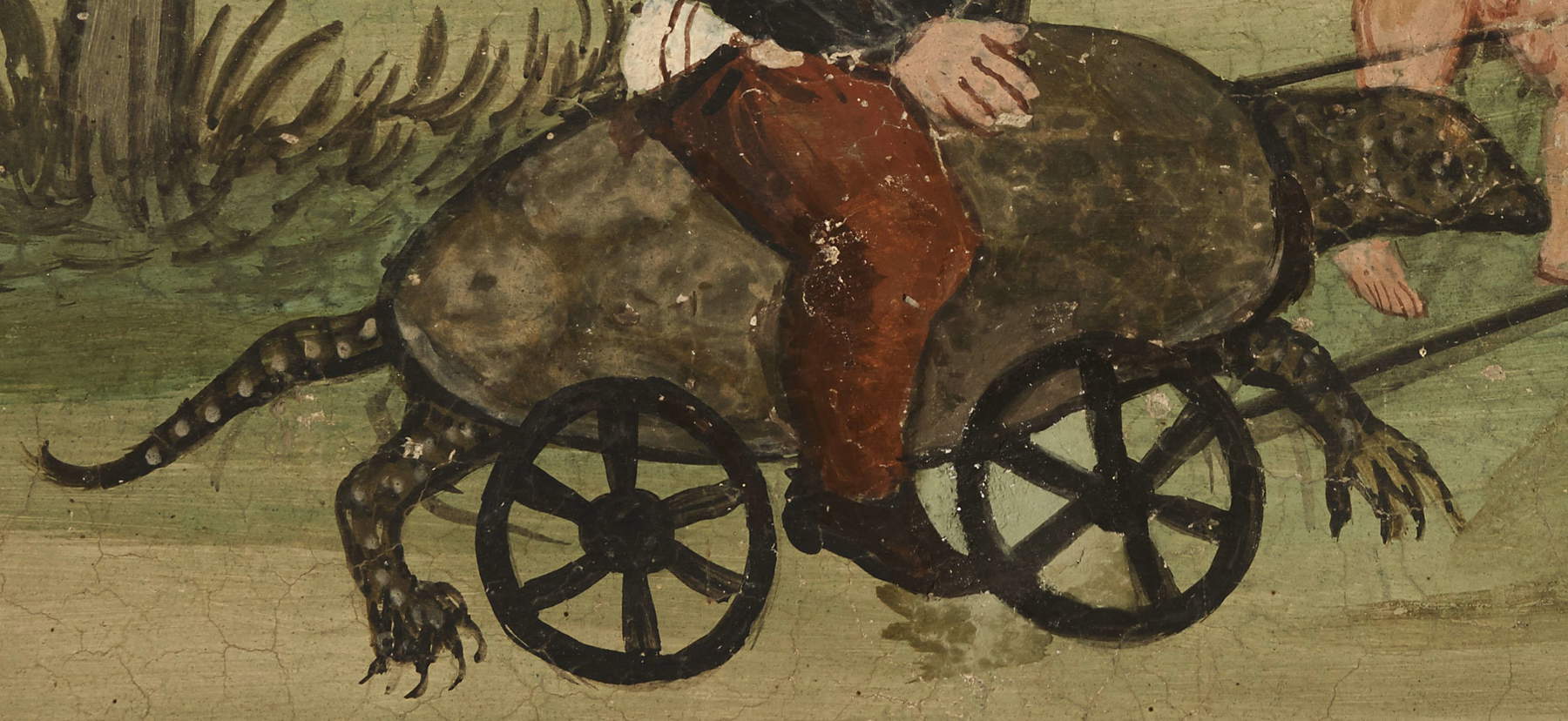
Ancient interpretation sees symbolized in this struggle the eternal struggle between Good and Evil [Giansanti 2012]. In particular, the rooster, used to crow at the rising sun, was the symbol of Christ(lux mundi, remember its presence above the cross especially in French churches), while the turtle was considered a symbol of evil. Its name in fact derives from the Greek “tartarouchos,” hence the Latin “tartaruchum”: “inhabitant of Tartarus,” inhabitant of the Underworld, of darkness and therefore a demonic being. The animal’s habits on the other hand favored this negative connotation since the animal lives in hibernation during the cold months and, when it is afraid, retracts into its carapace. In the Old Testament, the turtle is often depicted as an unclean animal and a symbol of evil and darkness: “Among the small animals that crawl upon the earth, you shall regard these as unclean: the mole, the mouse, and every species of lizard,the shrew, the frog, the turtle, the snail, the chameleon.” [Lev. 11:29]. In the first century AD, the writer Seneca classified the turtle as a slow and disgusting animal. In some Christian tablets from the first centuries of our era , reference is made to the “incredibly unclean spirit of the turtle,” and turtles were often depicted in art as “the personification of evil in combat” [Toynbee 1973]. St. Jerome, a church father who lived at the turn of the fourth and fifth centuries, reported that the turtle moves slowly because it is “made grave by its own weight...signifying the cumbersome sin of heretics” [Toynbee 1973]. Perhaps this ancient symbolism of the reptile may have inspired the author of the Palazzo Besta fresco in choosing it to represent the chariot of the Church of Rome as seen from the perspective of the Reformers.
Lastly, it should be noted that on a ceiling of the Palazzo Vecchio in Florence there is a depiction of a tortoise with a sail on its carapace and guided by several putti. Among them a putto holds her on a leash, another prods her from behind and a third pushes her. Above the fresco is the inscription “Festina Lente” (hasten slowly). The locution, combining two antithetical concepts, speed and slowness, stood for a way of acting without delay but with caution. Here the symbolism, of a different nature than that of Palazzo Besta, refers to Cosimo de Medici’s fleet in the 16th century, and is employed as a reminder to ponder enterprises in order for them to succeed. The turtle also appears here as a symbol of a slow and cautious gait.
With the choice of the tortoise, therefore, the artist wanted to refer to a secular, slow-moving animal that is a symbol of evil and gives the impression of immutability over time. In the same way, the Church of Rome was and is a secular institution, tending to preserve its nature over time, rigidly anchored in its dogmas, and which has walked and dominated the scene over the centuries at a cadenced and regular pace.
It should be noted that The Chariot as an allegory of the Church appears several times in literature and particularly in the Divine Comedy. At the end of the Purgatorio in cantos XXIX, XXX, XXXII and XXXIII Dante develops a grand allegory in which he sees a chariot drawn by a griffon and accompanied by a procession of seven women plus Beatrice approaching. The chariot then turns into a monster with seven heads and ten horns. Says Sapegno [Treccani 2005], “That the chariot is a symbol of the Church, is the concordant interpretation of all the ancient commentators; [...].” During that vision Beatrice exhorts Dante with the following words (Pg. XXXII, 100-105):
Qui sarai tu poco tempo silvano;
Esarai meco sanza fine cive
Di quella Roma onde Cristo è romano.
Però, In pro del mondo che mal vive,
Al carro tieni gli occhi, e quel che vedi,
Ritornato di la, fa che tu scrive.
As Sapegno said, for all ancient commentators, without exception, the chariot described by Beatrice represents the Church of Rome. And Dante is urged by his second guide (the Sophia) to keep his eyes fixed on the earthly affairs of this institution and relentlessly denounce its abuses. Following Dante observes and describes the gradual transformation of the chariot-church by narrating its main historical episodes: the heresies, the persecutions of the early Christians, the “mala” donation of Constantine (a historical forgery discovered in the 15th century by Lorenzo Valla) up to the Avignonese captivity. That Rome where Christ is Roman implicitly means that for Dante Christ does not inhabit earthly Rome [Soresina 2002]. Indeed, it will be the very first vicar of Christ, the apostle Peter, in canto XXVII of Paradise who will say of the pope and Rome (Pd. 22-27):
Quelli ch’usurpa in terra Il luogomio,
il luogo mio, il luogo mio che vaca
Nella presenza del Figliuol di Dio,
fatt’ha del cimitero mio cloaca
del sangue e della puzza; onde ’l perverso
che cadde di qua su, la giù si placa.
The fat dwarf astride the tortoise (Fig. 4) is the pope who is represented here as a man ungainly in form, disharmonious in features, short in stature, but smiling and sure of the direction in which he is proceeding. Cesare Ripa (1555-1622) was already pointing out that “the breaking of balance and therefore disproportion represents vice.” Those who have wished to see in this allegory only a figuration of Idleness have greatly underestimated the true scope of the artist’s message. In translation, the allegory is meant to emphasize that for the reformists of the time, popes often demonstrated that they indulged in vices, that they were easy prey to moral baseness, that they were not up to the spiritual task they were supposed to have for Christendom, but at the same time that they confidently walked forward aware of the almost absolute power of the institution to which they belonged. The pope’s colors are also symbolic: white, red and blue (dark). Red and blue are the same colors typically attributed to Christ’s robes in iconography (think of Leonardo’s Last Supper). Where red represents love, while blue represents spirituality. The white under the blue robe refers to purity. In this allegory they stand to indicate that these three virtues for the dwarf-pope are only a robe, a feature of the cloths and surface, for underneath lies the ungainly being mentioned above.
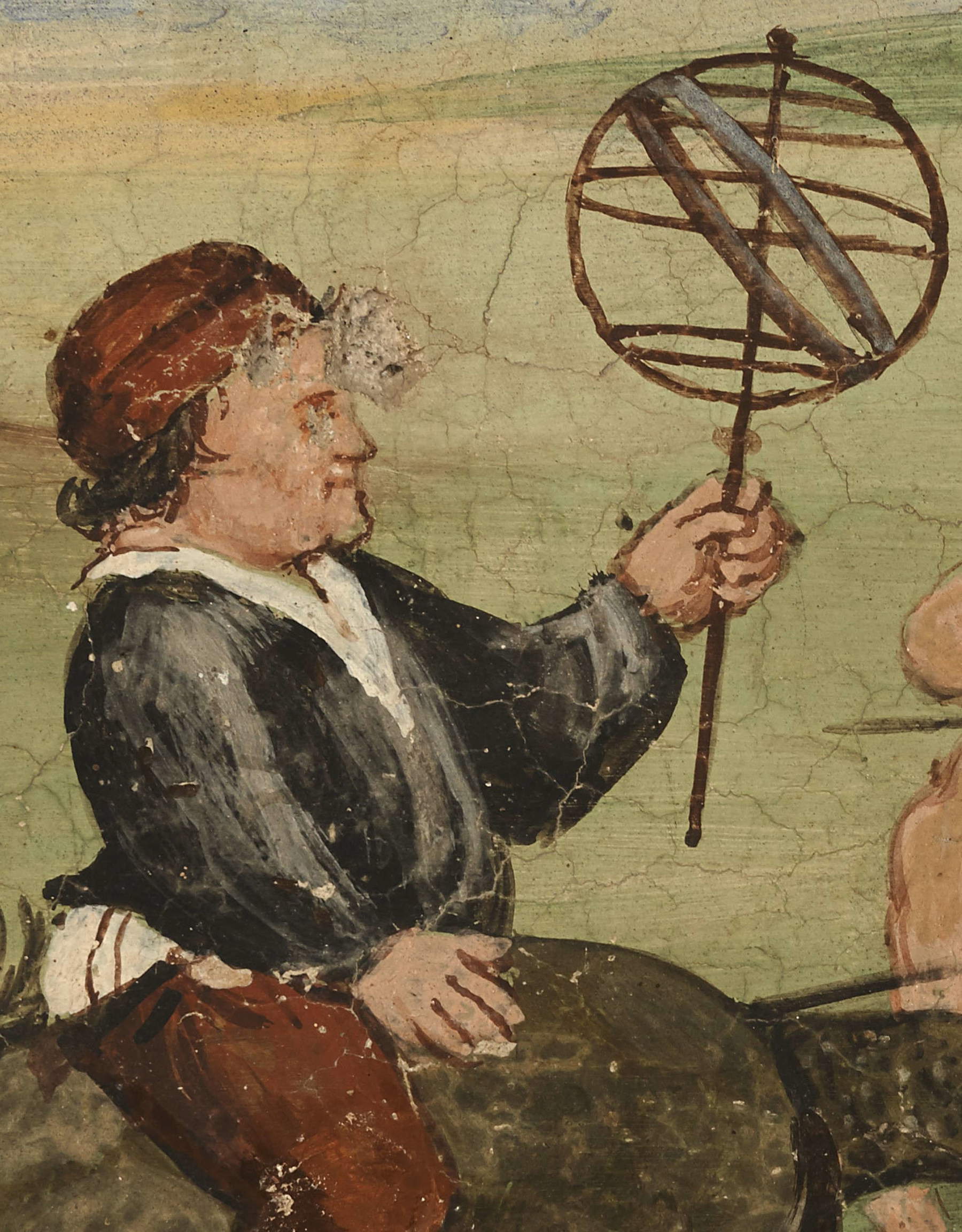
The dwarf-pope holds in his left hand an armillary sphere, the symbol of Heaven. The image is to indicate that the man holds the management of men’s relations with Heaven (hence “pontifex”), but he did it badly, in the wrong way, and for that reason the armillary is in his left hand and not in his right. The right VS left symbolism as an indication of “right” VS “wrong” or “moral” VS “immoral” is also present throughout antiquity and especially in Dante [Soresina 2009]. Suffice it to say that virtually all of hell is traveled in a descending “left-handed” direction (with a few but significant exceptions), while the mount of purgatory is always traveled by Dante in an ascending “right-handed” direction. Consider, for example, the description of Odysseus as he begins his “mad flight” past the Pillars of Hercules to the mount of purgatory (If. XXVI, 124-126):
E volta nostra poppa nel mattino
De’ omi facemmo alimo al folle volo
Sempre acquistando dal lato mancino
This triplet is loaded with clear symbols about Ulysses’ proceeding in the “wrong” Direction: the stern facing the morning, i.e., the boat heading westward, toward the night (while Dante in purgatory will be facing eastward, cf. Pg. I-20); the going to the left, the left-handed side, i.e., the wrong side. Whereas Dante in purgatory says to turn “to the right hand” (cf. Pg. I-22). The fact that Ulysses went in the wrong direction is then evidenced by the end of the episode in which a whirlwind born from the “nova terra” will cause the boat to sink along with its navigators, "com’altrui piacque.“ Figurative art of the Renaissance is also full of references to the right VS left concept: think, for example, of Michelangelo’s Last Judgment in which The Damned stand to the left of Christ, while those who are saved stand to his right. Or, finally, what the scriptures refer to when they say ”qui sedes ad dexteram patris." The apostle John himself, the one whom Jesus loved, is always represented at the right hand of Christ.
Again with reference to the physique of the dwarf-pope it is noted that the criticism of popes and prelates weighed down in the flesh by earthly things and immersed in vices is very present in Dante. The poet in Paradise has Pietro Damiano say (Pd. XXI, 130-135) with reference to the cloaked and horse-riding ecclesiastics:
Or voglion quince e quindi chi rincalzi
Li moderni pastori e chi li meni,
Tantoson gravi, e chi di retro alzzi li.
Cuopron d’I mantle loro I palafreni,
Sì che due bestie van sott’un pelle:
Opazienza che tanto sostieni!
The expression "Yes that two beasts van sott’una pelle" certainly needs no further comment.
The peasant women of the fresco (Fig. 5) in Palazzo Besta represent the “oxen” (and not surprisingly, they are at the yoke) and humble (barefoot) people who for 1,500 plus years have dragged the Church’s cart with endless suffering and hardship. See in particular the expression of toil and pain carved on their faces. The fact, then, that the author of the fresco chose women to pull the chariot can be seen in two different but complementary perspectives: on the one hand it perhaps stands to imply a critique of the misogynistic and contemptuous approach that the Church has too often had toward the world of women (think of the different role of women in relation to the ecclesiastical institution in the Protestant world). On the other hand, it could mean that the institution’s drag was achieved by appealing in part to people’s emotional side. The fact that precisely two were chosen would perhaps stand for one of the Church’s modes of leadership (borrowed from the Roman Empire), namely the exploitation of dualisms and divisions to exhaust the people and govern them more easily.
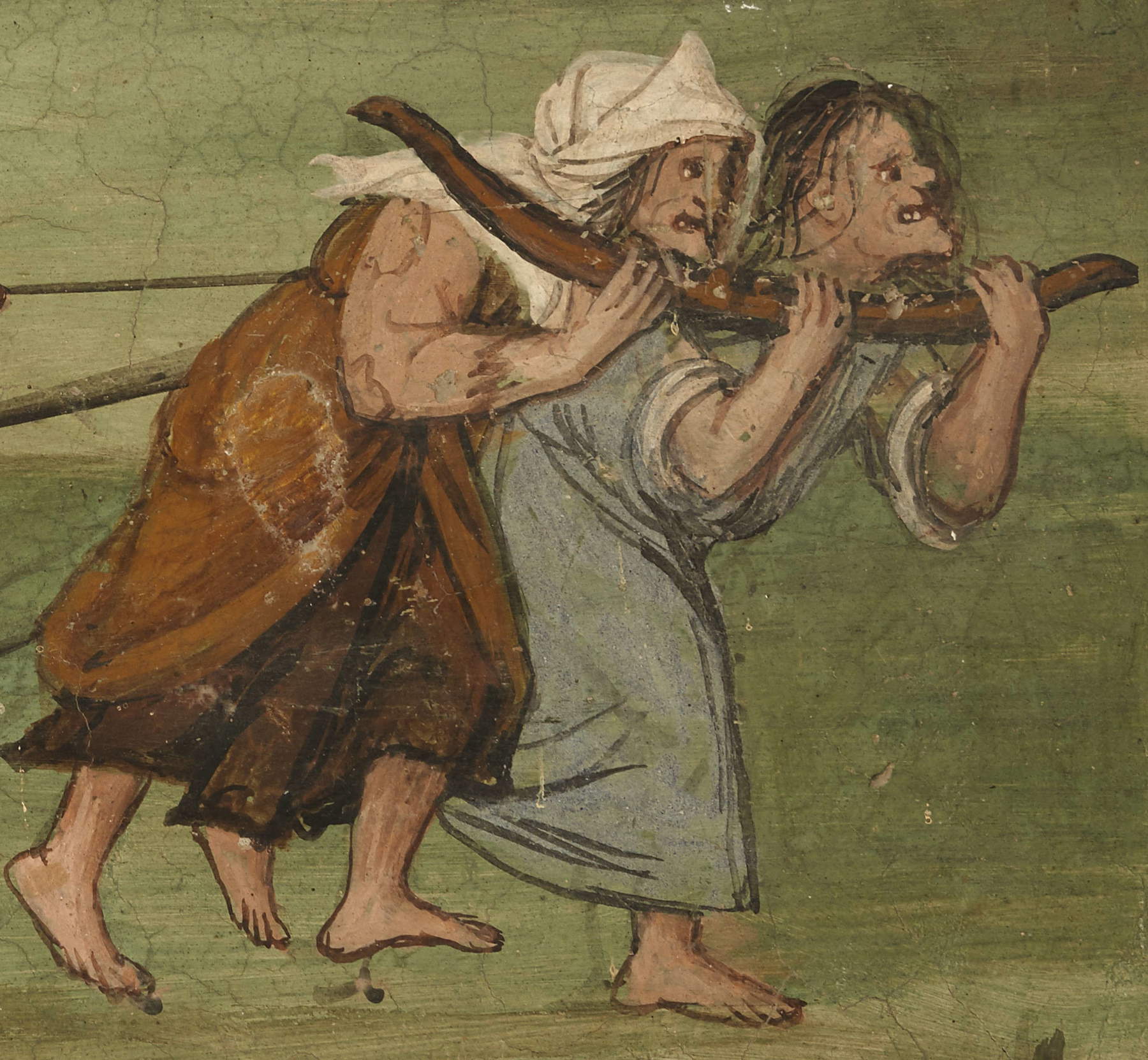
Building on the already cited Mazzoni Rajna [Mazzoni Rajna 1983], it is then possible to emphasize the artist’s choice to depict one of the two women as veiled, while the other is disheveled. The veil typically represents the symbol of estrangement from the outer world [The Universal 2003, entry “Veil”], while the dishevelment may represent transportation by the emotions and the strong influence of the earthly/material element. It is as if the two women dragging the chariot-church do so influenced by two different and in some ways diametrical natures: either by excessive detachment from the material world (hyper-spiritualization), or by excessive attachment to emotions and earthly things. In this regard it is interesting to quote Rudolf Steiner’s analysis in “Michael’s Mission” [Steiner 1919] about these two opposing attitudes of human nature: “The animic life of us men is like a yoke of scales , seeking the balance between the Luciferian element (read intellectual and hyper-cerebral in Steiner’s meaning) on the one hand, and the Arymanic element (read materialistic) on the other hand.” In order for man not to be lost and to live his life with fullness, the two attitudes for Steiner must be balanced and equilibrated only by “interpenetrating the Christ impulse.” As long as only one of the above two aspects pervades totalizing individuals, then they will be slaves to external forces and easily subjected to yokes such as the one that binds the two commoners in the Palazzo Besta fresco.
Leonardo da Vinci sends a similar message to the viewer of his Christ in the Last Supper, depicting him with one hand turned toward heaven and one toward earth (as in heaven so on earth). The image is meant to indicate that a full life cannot be achieved if, like Christ, we do not harmoniously combine our spiritual and earthly parts. Exceeding in one as well as the other will not make us “land in glorious harbor.” Similar is the message in Raphael’s School of Athens, where the two central figures, Aristotle and Plato, point to Earth and Heaven, respectively.
The putto undoubtedly represents an echo of an image of innocence (Fig. 6). However, such innocence is only apparent, for, analyzing it more closely, that putto is an ugly, middle-aged, balding man who, with cruel and sadistic manner, goads the commoners to pull the chariot. For The Reformers in fact, the Church of Rome in fact convinced/prompted the people to pull the “wagon” by giving of itself an image of innocence and holiness that never matched reality. A false innocence as well as that naked man who is for all intents and purposes a false putto. About the details of the putto’s face, however, it should not be discarded that its ugliness may also stem from the poor painting skills of the artist, an honest provincial artist but certainly not first-rate in rendering details. In the terms described above and within the spirit of the sixteenth-century Protestant Reformation, the symbols encoded behind the allegory of the chariot-turtle in the hall of honor of Teglio’s Palazzo Besta should be seen, in the writer’s opinion.
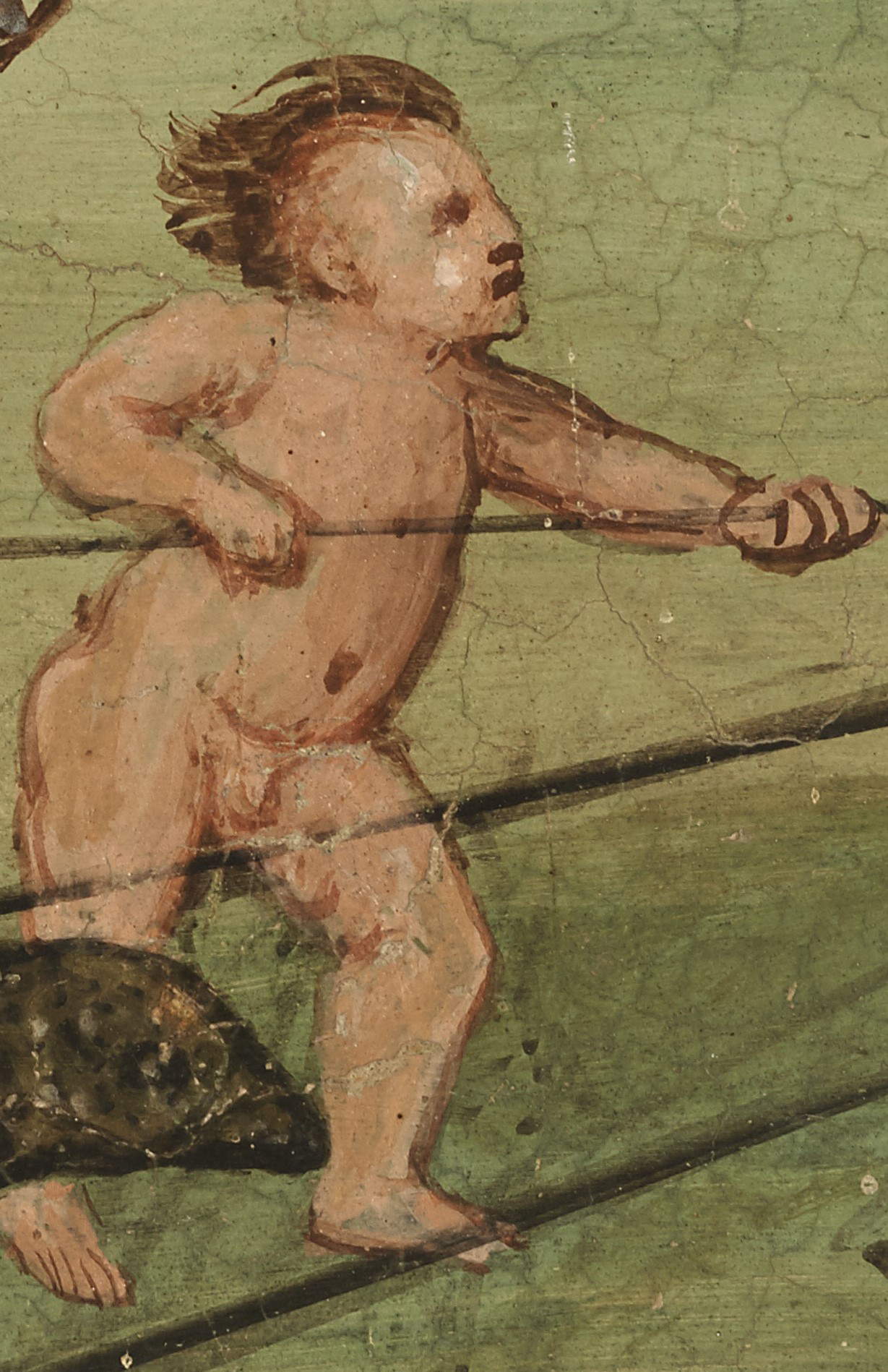
On one thing almost all those who have ventured to interpret the cycle of frescoes within which this is located agree, namely that it follows two allegories of greed. Some have wanted to see in it a representation of Idleness at the end of the cupidity series. However, this is not the case in the opinion of the writer.
Covetousness is still central in this depiction of the Church of Rome as well, since it was the main vice that was levelled at that institution, which was accused in the reformist circles of being more concerned with earthly things while forgetting their supposed role as trammels with Heaven. It is not by chance that always in the Divine Comedy greed is represented by Dante with the she-wolf ("che di tutte brame sembra carca") who bars the way for the poet at the beginning of Hell. The choice of the she-wolf (and not the wolf!) is an obvious reference to Rome and the Papacy that they identified with at the time (the symbol of Rome is the Capitoline she-wolf that suckled Romulus and Remus). Throughout the Middle Ages and beyond, saying Rome and saying papacy meant the same thing.
This interpretation would also seem to be confirmed by the two panels in the Palazzo Besta that predate the allegory of the “chariot-turtle,” also like this one placed on the south wall of the hall of honor (toward Rome for a Valtellinese looking in this direction). They refer to that part of the Ariosto cycle where Malagigi describes the sculptures that adorn the fountain of the Magician Merlin [Canto XXVI str. 29-47]. The sculptures depict a beast "hateful and ugly, who had the ears of an ass, and the head of a wolf and teeth, and by great hunger dry: gills he had of a lion, the other remaining all was fox.“ The beast, a sophisticated version of Dante’s she-wolf, certainly represents greed, which in its apotheosis is characterized by the gluttony (she-wolf) of those affected, uses weapons such as cunning (fox) and strength (lion), and is often accompanied by ignorance and presumption (donkey, in the negative sense of its symbol). A sort of tetramorph of vice that in the panels of the Palazzo Besta cycle wreaks havoc on simple and powerful men and particularly in the ”Roman court“ where ”contaminated had the beautiful seat of Peter and put scandal in the faith“ (str. 32). And so it is precisely of the ”Roman court,“ in full continuity with the two tables to which all critics attribute the sense of cupidity, that the ”chariot-parrot" that is the subject of this writing also speaks and fits in.
It is also pointed out that wolves in ancient Rome were also prostitutes, and this aspect relates to another invective uttered by Dante in Canto XIX of hell where, encountering The simoniac popes and addressing Nicolas III he says (If. XIX, 106-110):
Di voi pastor s’accorse il Vangelista,
Quando colei che siede sopra l’acque
Puttaneggiarcoi regi a lui fu vista;
Quella che con le sette teste nacque,
E da le diece corna ebbe argomento.
The “Vangelist” here is John, author of Revelation, who sees the one who sits above the waters (the church) prostituting herself with kings, as was the norm for the Church of Rome at the time to maintain power. The corrupt church was the magna meretrix, and all proponents of reforming its customs, such as the reformists, were loudly pointing this out at the time. Cathars, Rosicrucians, Patarines and the like who were exterminated in the persecutions. As mentioned earlier, it is then said that the Church was born with seven heads and had as its instrument ten horns. Of course, the Church is never mentioned explicitly, but the symbols are clear: the seven heads are the seven necks of Rome and the ten horns the commandments of the Decalogue “to which it adhered faithfully as long as it was ruled by virtuous pontiffs” [Sapegno 2005]. Also in the Apocalypse of John, the magna meretrix is also called Babylon, and another fresco in the Creation Room of the Besta Palace refers to it. The fresco, below, shows the tower of Babel under construction (Fig. 7). The frescoes in the Creation room were executed at the behest of Anna Travers, the Protestant wife of Charles I Besta.
The tower of Babel depicted has, on the one hand, a striking resemblance to the Colosseum (see the arches as they are arranged in Fig. 8), and on the other hand it stands near an obelisk. Note also that the number of arches at the base of the Colosseum in Rome seen from the front is between 15 and 16 depending on the distance from which the photo is taken. The number of arches at the base of the Tower of Babel in the Creation Hall fresco is 15. A remarkable similarity. While no associations between Babylon and obelisks could be found in the literature, Rome, as is well known, in addition to having the Colosseum, also has 12 obelisks smuggled out of Egypt by the Roman Empire. For these reasons there is good reason to believe that the artist of the fresco in the Creation Hall wanted to allude to the same Babylon/Rome of John’s Revelation.
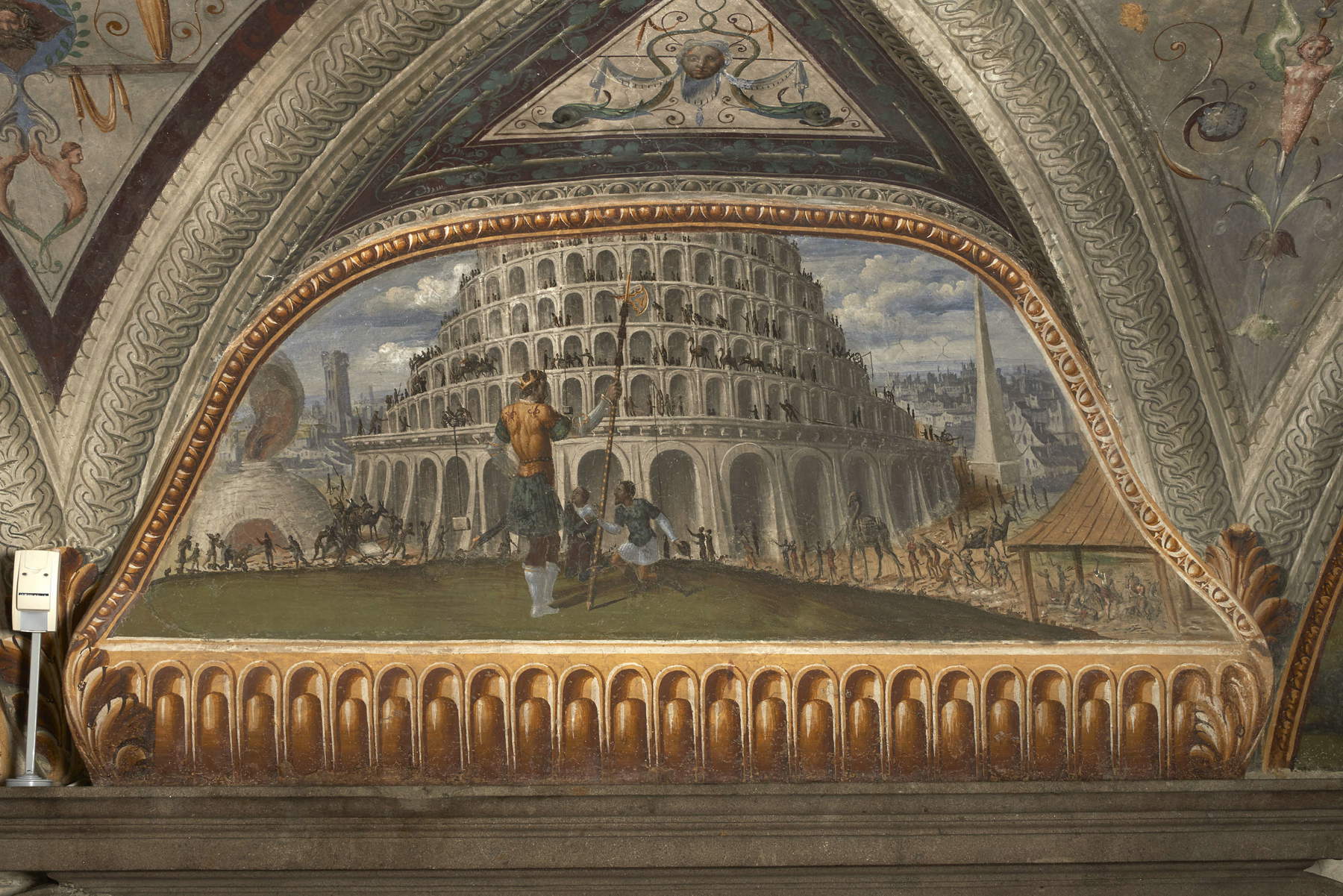
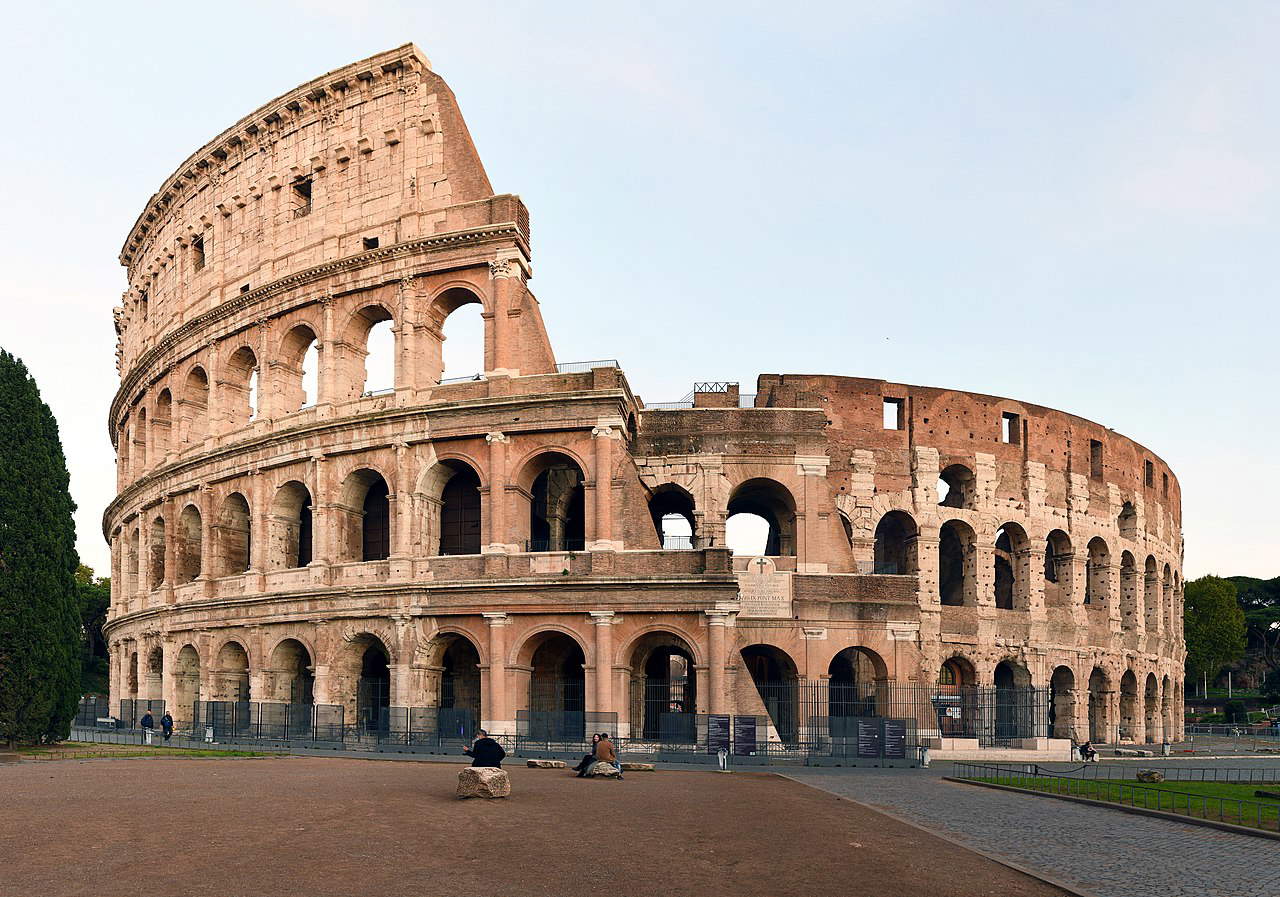
Teglio’s Palazzo Besta thus features several frescoes carrying a message of protest and harsh criticism of the Church of Rome of the times. The need to proceed by covered and unspoken symbols and allusions was obviously dictated at the time by the need to protect against persecution.
Interpretations of the allegory based on alleged depictions of idleness, “White magicians,” or the like, are in the writer’s opinion far removed from the true message the author intended to convey. While such a circumstance prevented a clear view of what was behind the images, it can be said that it fortunately enabled the work to be preserved from any wills of censorship and erasure that might have been had by the “masters of steam” in centuries past. Figurative art, like writing, through the ambiguity of symbols has always allowed the expression of protests visible only to those who had “eyes to see” [Strauss 1990].
In the present work, we wanted to analyze in detail the symbolic meaning hidden behind one of the allegories in the hall of honor of the Besta Palace in Teglio. The fresco, depicting a dwarf riding a tortoise-cart, represents in the author’s opinion a fierce criticism of the Church of Rome and the papacy of the time. The parallelism with the symbolic depictions in Dante’s Comedy served as a guide and support in the interpretation of the fresco. The papacy, at the time of the flourishing court of Azzo II and his wife Agnese Quadrio, was certainly seen in reformist circles as a center of power sidetracked in greed and oblivious to the original message of Christ.
I would like to thank Professor Maria Carla Fay, a luminous guide during my high school years. To her I owe the “discovery” of Palazzo Besta with its treasures and valuable advice during the writing of this paper.
I would also like to thank the management of Palazzo Besta for agreeing to the publication of the images shown in the text.
Finally, thanks are due to one of the referees of the journal Finestre Sull’Arte for The valuable comments that allowed the present work to be greatly improved.
Beniculturali, https://museilombardia.cultura.gov.it/musei/palazzo-besta/, 2024.
Birolli Zeno, “Fermo Stella,” in Pittori bergamaschi del Cinquecento, Bergamo, 1976.
Fay Maria Carla, Materietti Alessandro, "The irruption of novum in a small court in the heart of the Alps," in Orlando Furioso, 1516/2016, V Centenary in Valtellina, pamphlet published under the patronage of the Ministry for Cultural Heritage and Tourism, Sondrio, 2016.
Galletti Giorgio, Mulazzani Germano, “The Besta Palace of Teglio. A Renaissance dwelling in Valtellina,” Banca Piccolo Credito Valtellinese Ed., Sondrio, 1983
Gatti Perer Maria Luisa, “Precisazioni su Palazzo Besta,” in “Arte Lombarda” no. 67, pp. 7-69, 1984.
Giansanti Anna Pia, “The Rooster and the Turtle,” in EVUS, La Storia Svelata, 2012. Link: https://evus.it/it/index.php/news/reportage/il-gallo-e-la-tartaruga-2/
L’Universale, The Great Thematic Encyclopedia, “Encyclopedia of Symbols,” Garzanti Libri, 2003.
Prati Giacomo Maria (ed.), “L’Orlando Furioso in Valtellina,” Palazzo Besta in Teglio, July 4-September 10, 2009.
Ripa Cesare, “Iconologia del Cavalier Ripa,” Cristoforo Tomasini in Venetia, 1645.
Sapegno Natalino, in “Enciclopedia Dantesca,” Treccani, 2005.
Soresina Maria, “The Secret Things. Dante between Hinduism and medieval heresies,” Moretti and Vitali, 2002.
Soresina Maria, “Freedom Goes Seeking. Catharism in Dante’s Comedy,” Moretti and Vitali, 2009.
Steiner Rudolf, “Michael’s Mission,” Dornach 1919, Reissued by Editrice Antroposofica Milano, 2020.
Strauss Leo, “Writing and Persecution,” Marsilio, 1990.
Toynbee Jocelyn, “Animals in Roman life and art,” Thames and Hudson, London 1973.
The views expressed in this paper belong to the author alone and in no way reflect those of the firm for which he works or those mentioned in the acknowledgments.
Warning: the translation into English of the original Italian article was created using automatic tools. We undertake to review all articles, but we do not guarantee the total absence of inaccuracies in the translation due to the program. You can find the original by clicking on the ITA button. If you find any mistake,please contact us.